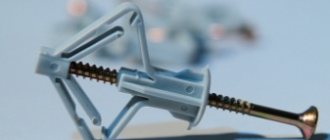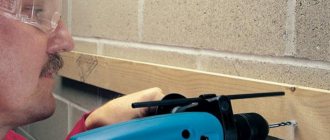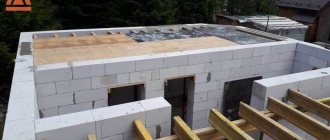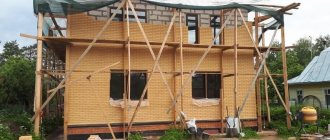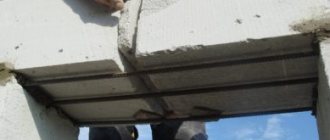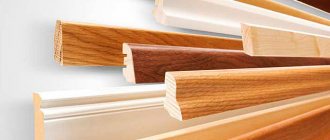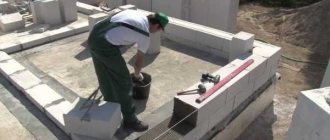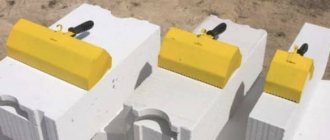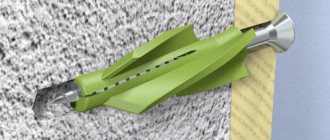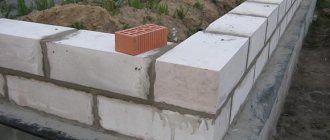Aerated concrete is often used in the construction of houses and other premises, so it is important to understand the technology for fastening dowels into aerated concrete. Due to the porous texture of aerated concrete, you need to carefully consider the fastening connection. On sale you can find special fasteners for aerated concrete. Please note that not all dowels can be attached to porous material. In this article, we will look at the features of dowels, the specifics of their fastening, and the key rules that should be followed when working with products.
Aerated concrete - what kind of material is it?
This is an affordable material suitable for the construction of houses and buildings. The main difference between aerated concrete is its porous structure, which is why it is considered fragile and easy to work with. You can easily cut the material to the desired configuration, trim it or trim it according to a template. Conventional dowels cannot be used because they cannot guarantee secure fastening.
In this case, only special dowels for aerated concrete are suitable. They differ from traditional ones in design. The bushing has a spiral shape with a grooved surface. The ribs located on the outside expand when screwed in. They easily fit into the loose structure, ensuring a reliable connection. This design can withstand heavy loads. Using dowels, you can attach cabinets, shelves, and decorative items to walls.
Dowel for aerated concrete - design features
The soft and friable materials from which walls are built have always been problematic when it comes to attaching various household products to them. As a result, not a single manufacturer of fastening structures gave a guarantee that their anchor or self-tapping screw would adhere well to such a surface. In practice, this was very often confirmed; the soft base simply crumbled, and the fasteners lost their holding properties.
But a solution was found, it was the dowel for aerated concrete that solved the problems of installation in soft materials. The immediate solution to this issue was the specific design of such fasteners. Externally, this is a sleeve on which there are ribs made in the form of a spiral; when installing a self-tapping screw, it expands the sleeve, which, with spiral-shaped ribs, seems to cut into the soft surface of aerated concrete. As a result, we get a strong mount that holds a certain load.
Fasteners of this category are available in two versions, plastic and metal. As for the metal version, its design can also be of two types. The first design sample has the same wide spirals on its base as the plastic one, and the method of its fastening is completely identical to its plastic counterpart.
The second type of such dowel has a completely different design. It is made in the form of a bushing, which has teeth along its entire length, and the main feature is its cone-shaped shape, increasing from the bottom edge to the base. On the working surface with teeth, the metal has technical slots, which expand when the bolt or screw is tightened, and the teeth also bite tightly into the soft material.
What types of dowels are there?
All dowels differ in the shape of the ribs for fixation and the installation method. Dowels can be driven or screwed into the base. Screwing dowels into aerated concrete is considered the most reliable method. Let's look at the main types of fasteners that can be found on sale:
- Metal. For their production, galvanized steel is mainly used. The fasteners are highly fire resistant, can withstand heavy loads and are used for installing various pipelines. Metal dowels have a special collar that prevents rotation. The main disadvantage of metal dowels is the risk of corrosion. For aerated concrete, a metal dowel is suitable.
- Plastic. Made from durable materials that will not rust over the years. Mostly plastic products have ribs in the form of spirals. They provide a reliable connection to porous materials. Plastic dowels are environmentally friendly and can guarantee a strong fastening. Plastic is not exposed to aggressive factors, so dowels are quite common. The cost of plastic fasteners is an order of magnitude cheaper than their metal counterparts. Experts do not recommend plastic dowels for outdoor use due to their instability to temperature changes.
- Nylon. Such dowels, as well as plastic versions, are not subject to corrosion. The advantage of choosing nylon will be its strength and durability. Due to the relatively high cost, the demand for them is not so great. Most often, nylon dowels are used when installing doors, windows, and mirrors.
- Chemical. A special dowel for aerated concrete, which is used for installing large and heavy objects. Chemical anchors come to the rescue in cases where standard metal fasteners cannot cope with the task. When installing a chemical anchor, it is installed in the pilot hole with a special adhesive applied for more reliable fixation.
- Universal. Suitable for all types of surfaces, including porous aerated concrete. The design includes a spacer part. When immersing hardware, the universal dowel fixes it according to the principle of a standard expansion-type dowel.
- Gvozdeva. It is also called a dowel-nail. The structure provides for two struts without a toothed covering. When installing a nail dowel, you need to install a sleeve. It will prevent the hardware from scrolling. Anchor nails are budget fasteners designed for objects of insignificant weight. The main advantage is considered to be simple installation.
- Frame. There are models made of plastic and metal. Frame dowels are great for loose surfaces because they correctly distribute the load, which is mostly placed on the fastener itself.
- Thermal insulation. Most often used for fixing insulation. Suitable for working with concrete, brick and softer surfaces.
Types and features
The dowel fastening device is a sleeve with four “petals” and a rough surface. When twisted or hammered, they begin to expand in the porous structure of aerated concrete. The teeth and incisors in such a device contribute to reliable fixation. They can be secured especially firmly when the teeth move in a spiral and the tip of the screw does not extend beyond the dowel.
Depending on the material used, fastening elements can be:
- metal - stainless steel, galvanized, brass, aluminum, with the addition of an anti-corrosion compound;
- plastic (polyethylene, polypropylene, nylon).
The first type is considered the most reliable in operation.
They are excellent for through-and-through and complex installations. However, such fasteners have a significant drawback - they begin to oxidize under prolonged exposure to moisture. They are equipped with supporting elements to minimize the risk of heavy hardware turning or falling inside the aerated concrete blocks. READ Paint for concrete: types of wear-resistant materials for outdoor work Plastic fasteners are valued for their lightness, versatility and resistance to corrosion processes. Among all varieties, nylon dowels are considered the best
All these fasteners are divided into driven-in and screw-in, depending on the installation method. They are suitable for installation without pre-drilling the blocks, and they are also fixed using threads in a pre-prepared hole.
According to the type of thread and fixation of elements, bushings can be standard with the same cross-sectional length and helical spiral. There are cone-shaped hardware that spread out to the sides with blades when twisted. Some begin to expand when the structure expands.
A separate group includes chemical anchors. Their fixation occurs due to the polymerization of a special composition. They are very convenient to use, since you just need to place the capsule in the prepared place.
Metal dowels
These fasteners are fire resistant and are therefore often used in areas where there is a risk of fire. Metal dowels have a locking collar , which is also called a “cuff.” At the moment of twisting, it prevents the bushing from rotating around its axis and prevents it from falling into the wall. Most often they are made from galvanized steel.
Metal dowels for aerated concrete are used when performing the following work:
- for installing equipment and furniture with impressive weight;
- fixation of pipelines, including the most complex ones;
- fastening guides designed for installation of gypsum board sheets.
However, such metal fasteners have their drawbacks. Over time, they develop destructive rust. Fasteners made of galvanized steel are considered the best and for this reason are expensive. Due to their positive qualities, they are often reused.
Plastic and nylon fasteners
Such fasteners are good because they are not affected by corrosion processes.
The plastic dowel for aerated concrete has special spiral-shaped ribs. This part of the part is responsible for maximum adhesion to the cellular structure of the material. The main advantage of plastic fasteners is environmental friendliness. The advantages also include resistance to aggressive environmental influences. READ Application and technical characteristics of concrete contact primer
They are characterized by their low cost, which makes them indispensable and always in demand when working with aerated concrete. Despite all the positive characteristics, they are not suitable for use on facade surfaces. Their significant disadvantage is poor resistance to sub-zero temperatures. In winter, during frosts, such a fastening can easily burst.
Nylon options are also corrosion-resistant. However, they are more wear-resistant than their plastic counterparts. They are often used for outdoor work. Nylon dowels for aerated concrete are considered much stronger and more durable. They are much more expensive in cost, so they are not often purchased by consumers.
The high price is fully justified, since the characteristics of the clamps allow them to be used for many jobs. For example, they are used to install window and door openings. This is an excellent option for attaching mirrors and installing lighting fixtures if you use fasteners with a diameter of no more than 12 mm.
Chemical anchor
Often it is necessary to mount massive objects on aerated concrete surfaces. In this case, chemical anchors are used. Metal dowels, compared to anchor bolts, will not be able to withstand very heavy weight. They are sent to the prepared place using a special adhesive composition.
This method of fastening gives a 100% guarantee that a large object will be securely fixed and will last for a long period.
Which dowel for aerated concrete is better?
To choose the most suitable dowel from the options described above, pay attention to the following recommendations from experts:
- to fix mirrors, lamps and similar items, use nylon dowels;
- for outdoor work, choose metal fasteners;
- when installing large and heavy objects, metal dowels are better suited;
- for reliable facade connections - special fasteners made of durable plastic;
- when installing windows or doors, frame dowels will be a priority;
- to fix decorative objects, you can limit yourself to a regular nail without a dowel.
Installing dowels in aerated concrete: step-by-step guide
The principle of installing dowels in aerated concrete is practically no different from other surfaces. Focus on the following rules:
- It is important to make a pilot hole that matches the diameter of the dowel. It is important that the hole is smaller than the fastener. For example, for 10 mm fasteners you need to prepare a hole with a diameter of 9 mm.
- When working with a hammer drill, avoid impact mode. A drill is considered a more suitable tool.
- A screwdriver is suitable for screwing in the plastic dowel. With metal dowels, use a hammer.
- After installing the cuff all the way, proceed to screwing in the self-tapping screw.
Dowel
Fastening for aerated concrete blocks made of dowels is used for all types of concrete products. Traditional types of fasteners for aerated concrete walls:
- A dowel-nail made of steel enters the sleeve, while the part at the base opens and cuts into the structure of the material at a certain angle.
- The facade universal dowel is used when fastening a profile to an aerated concrete surface. For further installation of panels for the facade. The elements also allow you to hang wall cabinets and shelves.
- The nylon universal spacer dowel is used for attaching light shelves, curtains, baseboards, switches, and cable boxes.
- The frame dowel is installed when installing window and door frames and hanging furniture elements.
- A nylon dowel for a gas block is used with conventional self-tapping screws when installing facade subsystems made of wood and metal, windows, doors, suspended ceilings, pipelines and plumbing fixtures.
- Metal dowels with zinc coating are designed for a wide range of applications when working with any cellular concrete. They can also be used for attaching a gas block to a wall.
- A steel anchor for aerated concrete blocks will help solve such problems as fastening heavy objects - a boiler, an air conditioner, a hanging pipe, massive hanging furniture.
When the screws are screwed in, dowels made of galvanized steel move the segments apart, which allows the product to be securely fixed in the cellular material.
Why are adhesives applied when installing dowels?
Adhesive mixtures are special compounds that are used to ensure the reliability of complex joints. Most of them contain epoxy resin, which has many properties. The scope of use of adhesive compositions includes fixing concrete elements and creating connections in complex technical structures.
The popularity of using special tools when working with dowels is due to the following factors:
- possibility of fastening in an aggressive environment, under the influence of moisture;
- intended for external fastenings without the risk of deformation and loosening of connections;
- eliminating stress in the dowel itself.
If you are faced with a complex design and think that an adhesive composition is needed to fix an object on an aerated concrete base, choose an option that is suitable for the price.
Typical mistakes, fastening methods, recommendations when working with dowels
If you need to install a dowel in a loose aerated concrete surface, you should not use a screwdriver. If your tool has a speed control feature, that's good. Correctly calculate the diameter of the hole itself from the rule described above: the dowel must be larger than the hole. Otherwise, reliable fixation cannot be guaranteed.
The depth of the hole should be slightly larger than the dowel itself. Please note that dowels should only be used for their intended purpose. Despite their versatility and ease of installation, experts do not recommend using such products when installing large and heavy objects. Dowels are most suitable for solving small household tasks - attaching pictures, hooks and other objects.
It is allowed to use dowels for heavier weights, but subject to mandatory compliance with all rules. The information obtained will allow you to correctly determine the type of suitable fastener and avoid common mistakes.
